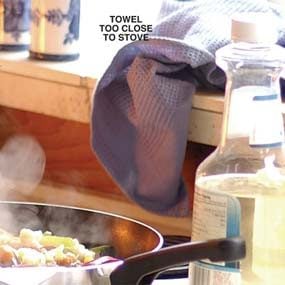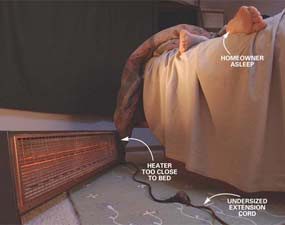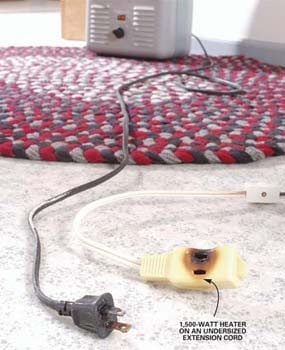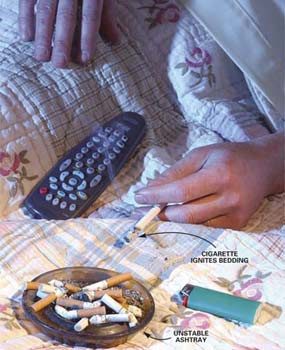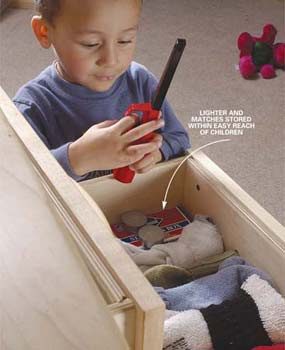How to Prevent Home Fires
Updated: Aug. 02, 2023Most heartbreaking losses are surprisingly easy to prevent. This guide tells you how.
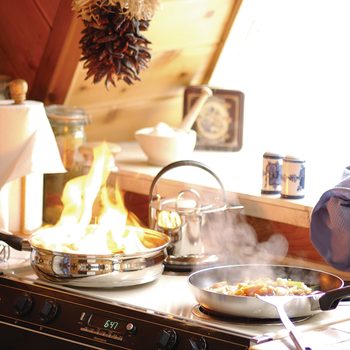
- Time
- Complexity
- Cost
- An hour or less
- Beginner
- Free
Overview of preventable home fires
Most fires are unexpected because they’re caused by the most ordinary, everyday items that you normally consider safe: a stove burner, a candle, an electric space heater, the water heater, an extension cord, a cigarette. What typically makes them dangerous are mental lapses, poor judgment, hurried actions and simple carelessness. While everyone makes mistakes, you can vastly cut down deadly fire risks by exercising good safety habits and simple prevention steps. In this article, we’ll outline the “Big 7” most common causes of preventable fires and tell you the simple things you can and should do to keep them from starting.
A Word About Smoke Alarms
According to statistics, this year fire will claim the lives of 30 of our readers and the homes of 500 others. Don’t become part of this statistic. Well over 60 percent of house-fire fatalities occur in homes that are missing smoke alarms or have disabled alarms or alarms with dead batteries. Test your smoke alarms every month and replace units that are more than 10 years old.
#1 Fire Source: Stoves and cook tops
The statistics: Cooking fires cause 23% of home fires and 9% of deaths.
The grease in an unattended frying pan catches on fire and ignites nearby combustibles, which in turn ignite curtains, cabinets or anything else in the vicinity.
A true fire story:
WAUSAU, WI—A sleeping 4-year-old girl died of smoke inhalation in a house fire that started about 30 minutes after her mother left her alone to run errands. Apparently, a stove burner was left on under a frying pan containing grease used for frying chicken. She was the only person home at the time of the fire.
On average, every year one out of every eight homes will have a kitchen cooking fire. Cooking fires mostly occur on the cooktop, usually in the first 15 minutes of cooking. A common scenario is an unattended frying pan on a hot burner. If a fire starts, don’t carry the pan outside; slip a lid over the flames from the side to keep from burning your arm. Many grease fires become full-scale house fires when a flaming pan is carried through the house, dripping a flaming grease trail all the way to the door.
Cooking Fires: The Solution
- Never leave the kitchen while something is cooking on the stove.
- Keep combustibles at least 3 ft. away from the cooktop. This includes curtains and wall hangings.
Tip: Post a reminder note near the range for a week or two until everyone gets the message.
#2 Fire Source: Heating equipment
The statistics: Heating equipment causes 15% of home fires and 13% of deaths.
Wood stoves and space heaters igniting nearby combustibles are responsible for the lion’s share of heating fires.
A true fire story:
WINSTON-SALEM, NC—An electric space heater caused the death of a 3-month-old infant left at home with her brother and her two sisters early one morning, fire officials said. Manuel, age 11, smelled smoke in an upstairs room and was able to get two of his sisters outside but was unable to rescue his 3-month-old sister, who was asleep in the master bedroom. An electric space heater in the bedroom appears to have ignited a nearby pile of clothes. The mother was driving her husband to work when the fire started. A smoke detector had been installed near the kitchen, but the family took it down because it would go off when they cooked.
Most deaths from heating equipment occur when wood stoves and space heaters are in use and ignite nearby combustibles while everyone’s asleep. Here are other common ways that wood stoves cause fires:
- If they’re not disposed of properly, embers in discarded ashes smolder for up to two weeks and can ignite other trash.
- Chimney disrepair and creosote buildup can combine to create a chimney fire that can ignite adjoining wall framing.
- Sparks or even just heat can ignite combustibles that are located too close to the wood stove.
Heating Equipment: The Solution
- Keep space heaters at least 3 ft. away from drapes, bedding and other flammables.
- Plug space heaters directly into outlets, not into extension cords.
- Don’t use space heaters while sleeping.
- Empty wood-stove ashes in a metal container and store them outside away from combustibles for at least a week before dumping them into the trash.
- Have your chimney inspected and cleaned every year.
- Keep any and all combustible objects at least 5 ft. away from the stove or fireplace.
Tip: Establish a designated space heater zone in rooms where space heaters are used. The zone should be clear of blowing drapes and at least 5 ft. away from other combustibles.
#3 Fire Source: Electrical equipment
The statistics: Electrical equipment causes 9% of home fires and 10% of deaths.
Overloaded extension cords, hidden electrical shorts, bad connections, and oversized bulbs and fixtures can ignite nearby combustibles and burn down your house.
A true fire story:
FLORIDA—Fire and smoke spread through a single-story home, killing two in a late-night blaze. Investigators determined that an electrical short in a five-outlet power strip overloaded with seven appliances started the fire. Excessive heat melted plastic wires and ignited the carpet and a television stand. Crews doused the flames and removed a 74-year-old man and a 59-year-old woman from the home. The man had already died of smoke inhalation and the woman later succumbed to second- and third-degree burns.
Electricity and heat caused by shorts, overloading or bad connections go hand in hand. The heat generated is often enough to ignite combustibles such as wood framing, rugs or even the insulation around the cord or wire. While a few of the electrical causes are tough to spot, there are telltale clues that can tip you off to dangerous concealed wiring hazards.
- Electrical cords that are warm to the touch can signal overloading.
- Charred or plastic burning odors may indicate oversized bulbs and light fixtures.
- Warm switch or receptacle plate covers may mean a poor electrical connection.
- Frequently tripping circuit breakers may be caused by a defective breaker or possibly a short in the cables buried in walls or ceilings.
Electrical Fires: The Solution
- Replace extension cords that are undersized or frayed.
- Never run extension cords under rugs.
- Replace undersized cords with larger-gauged ones or plug appliances directly into outlets.
- Call an electrician to track down hidden problems causing frequently tripping circuit breakers.
- Call an electrician to open up and troubleshoot electrical boxes that have warm covers.
- Check all the light bulbs in your home to make sure bulb wattages don’t exceed the fixture’s recommended maximum. Learn how to put out an electrical fire.
#4 Fire source: Appliances
Appliances (clothes dryers and gas water heaters) cause 7% of home fires and 4% of deaths.
After problems with stoves and heaters, the biggest culprits in appliance fires are lint in dryers and combustibles near gas water heaters. Invest in a residential fire sprinkler system to better protect your home.
A true fire story:
PORTSMOUTH, VA—Clothes piled against a water heater started a fire that took the life of a 7-year-old girl. A neighbor who noticed the fire was able to kick in the back door and rescue five of the children ages 2 to 10, but dense smoke made it impossible for him to save the 7-year-old. The mother had gone to the store and left the children in the care of her next-door neighbor, who wasn’t with the children when the fire broke out. A fire department spokesperson said, “There should be plenty of space between a water heater and any other materials,” and “there should never be anything within two feet of any heating appliance.”
Since water heaters are often in the same room as the laundry, clothes tend to get piled up against the water heater near the flame. The problem is worse when that flimsy cover plate falls off the burner access. Dryer vents catch on fire when built-up dust and lint ignite from either the burners or the heating elements and create a fire path to built-up lint within the vent hose. Especially dangerous are dryers that are vented with flexible vinyl hoses. The vinyl then catches on fire and lights anything near it.
Appliances: The Solution
- Make sure protective water heater combustion chamber covers are in place.
- Pull the back service panel from the dryer cabinet and clean all the lint from the interior and around the drum.
- Clean built-up lint from the vent line.
- Replace vinyl vent lines with smooth-walled metal ducts.
Tip: Mark a “combustible-free” zone 3 ft. away from your water heater with masking tape.
#5 Fire Source: Smoking
Cigarettes cause 5% of home fires and 23% of deaths.
Smoking kills more people than any other cause of fire because the fires usually start when everyone’s asleep.
A true fire story:
MINNESOTA—A man died after he fell asleep while smoking in bed. He awoke to find his bed and clothing in flames. Disoriented, he opened a closet and ignited the clothes hanging inside before struggling through the bedroom door and collapsing on the hallway floor where his clothes lit the carpeting on fire. He was pronounced dead at the scene and the fires were extinguished.
If a cigarette smolders in the bedclothes or drops on the carpet when the smoker falls asleep, the gases from smoldering fabrics will actually lull the smoker into a deeper and deeper sleep. Live butts that fall between cushions or are tossed into trash cans can take hours to ignite, and when they finally do, the household’s in bed, asleep.
Smoking: The Solution
- Don’t smoke in bed.
- Use large ashtrays on tables.
- Soak ashtrays under the faucet before throwing cigarette butts in the trash.
Tip: When nagging isn’t doing the trick, it might be time to buy a sign like the one in the photo.
#6 Fire Source: Candles
Candles cause 5% of home fires and 3% of deaths.
Like cooking fires, most candle fires occur when candles burn unattended near combustibles—usually in bedrooms.
A true fire story:
INDIANA—A 23-year-old woman and her two daughters, ages 11 months and 2 years, died when wind from an open window blew curtains across an unattended candle, spreading flames to nearby combustibles. The house had two smoke alarms, one battery operated, the other hard-wired. Both were inoperable. Firefighters found the 11-month-old girl in a crib in the living room, dead from smoke inhalation and burns. Her mother and sister were found next to a bed, dead of smoke inhalation. All three had been napping when the fire broke out.
The recent popularity of candles and the 50 percent surge in candle-initiated fires in the last 10 years is no coincidence. Couple that with burning candles near combustibles or on shaky holders and there’s a huge potential for a catastrophic fire. Using candles safely calls for the utmost in attention and care. They’re simply a high-risk item because you can easily set them near combustibles without noticing, leave them unattended and forget about them entirely. They’ll often get soft and fall out of a holder and ignite nearby combustibles or even ignite an underlying wooden holder or shelf. (It’s wishful thinking, but if I had my way, we’d only burn candles at the dinner table and nowhere else.)
Candles: The Solution
- Use only tip-proof containers.
- Burn candles only while you’re awake and in the same room with them.
- Keep candles at least 3 ft. away from combustibles.
- Never burn candles that have combustibles (flowers, leaves and potpourri) cast into the wax.
Tip: Go through your candle and candleholder collection and throw away tippy holders and candles with combustibles cast into them.
#7 Fire source: Children playing with fire
Children playing with fire cause 5% of home fires and 8% of deaths.
Not only do children playing with fire start 5 percent of the residential fires; they’re also the most likely ones to die from those fires.
A true fire story:
TENNESSEE—A 2-year-old and his 23-year-old mother died when a fire spread through the house. The children’s 28-year-old father, who rescued his three daughters before reentering the house to search for his wife and son, also died. There were no batteries in the kitchen’s smoke alarm. The fire apparently began in a front bedroom under a bed. They believe that one of the children was playing with a lighter or matches and ignited a foam mattress. Flames then spread to the hallway, living room and kitchen. A padlocked door prevented the victims from leaving the home.
Children will often start fires while hiding in places like closets or under beds, where they’re surrounded by combustibles. Their first reaction is often to hide from you or the fire after it starts. There, they become overcome by smoke and/or make it difficult for firefighters to find them. It’s obvious that you shouldn’t leave matches and lighters lying around, but you also have to be vigilant around burning candles.
Children Playing with Fire: The Solution
Store matches and lighters up high, well out of the reach of children.
